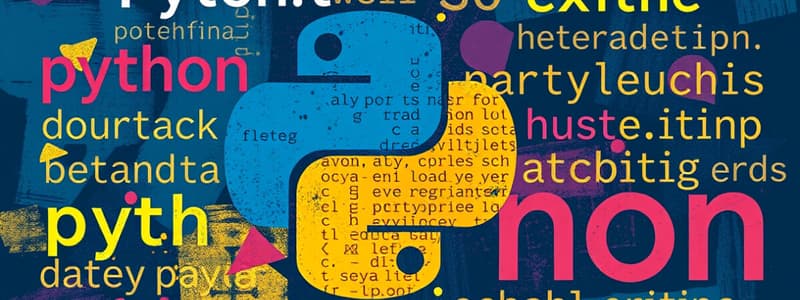Podcast
Questions and Answers
What are reserved words in Python, and what are they used for?
What are reserved words in Python, and what are they used for?
Reserved words in Python are keywords with predefined meanings used to define the syntax and structure of the language.
What special usage do identifiers in the form of words surrounded by underscores have in Python?
What special usage do identifiers in the form of words surrounded by underscores have in Python?
Identifiers in this form are used for special variables or methods, such as __init__ for constructors.
Name the primary data types available in Python.
Name the primary data types available in Python.
The primary data types in Python include integers, float numbers, complex numbers, strings, and Boolean values.
How are binary integers represented in Python?
How are binary integers represented in Python?
What is the method for representing hexadecimal integers in Python?
What is the method for representing hexadecimal integers in Python?
What are some operators that can be used with integers in Python?
What are some operators that can be used with integers in Python?
How are integers defined in Python, and what limits their size?
How are integers defined in Python, and what limits their size?
What built-in methods can you use on float numbers in Python?
What built-in methods can you use on float numbers in Python?
What is the main distinction between the / and // operators in Python?
What is the main distinction between the / and // operators in Python?
What does the modular operator (%) do in Python?
What does the modular operator (%) do in Python?
How are float numbers represented in Python?
How are float numbers represented in Python?
List the operators that can be used on float numbers in Python.
List the operators that can be used on float numbers in Python.
What is the limitation on the size of float numbers in Python?
What is the limitation on the size of float numbers in Python?
How can you convert a float number to an integer in Python?
How can you convert a float number to an integer in Python?
What constitutes a complex number in Python?
What constitutes a complex number in Python?
How are complex numbers represented in Python?
How are complex numbers represented in Python?
What is the purpose of the except clause in a try statement?
What is the purpose of the except clause in a try statement?
How can the else clause enhance exception handling in Python?
How can the else clause enhance exception handling in Python?
In what scenario is the finally clause used in a try statement?
In what scenario is the finally clause used in a try statement?
List the data types categorized as sequences in Python.
List the data types categorized as sequences in Python.
What distinguishes tuples from lists in Python?
What distinguishes tuples from lists in Python?
How do you access the second element in a list in Python?
How do you access the second element in a list in Python?
Explain the concept of slicing in sequences.
Explain the concept of slicing in sequences.
Provide an example of how to slice a list from index 1 to 3.
Provide an example of how to slice a list from index 1 to 3.
How can the property() function be utilized as a decorator in Python?
How can the property() function be utilized as a decorator in Python?
Define what constitutes a module in Python.
Define what constitutes a module in Python.
Can you explain the concept of a package in Python?
Can you explain the concept of a package in Python?
Why are modules and packages important in software development?
Why are modules and packages important in software development?
What is modular programming and its benefits?
What is modular programming and its benefits?
How does the use of @property enhance class design?
How does the use of @property enhance class design?
What is the primary advantage of using the property() function for encapsulation?
What is the primary advantage of using the property() function for encapsulation?
In what situation would using a package over a module be more beneficial?
In what situation would using a package over a module be more beneficial?
What is a terminal-based application and how does it relate to user interaction with the operating system?
What is a terminal-based application and how does it relate to user interaction with the operating system?
What distinguishes a GUI-based application from a terminal-based application?
What distinguishes a GUI-based application from a terminal-based application?
Can you name at least two libraries in Python that are commonly used for developing GUI-based applications?
Can you name at least two libraries in Python that are commonly used for developing GUI-based applications?
What is the purpose of the datetime module in Python?
What is the purpose of the datetime module in Python?
How does the shutil module enhance file system operations in Python?
How does the shutil module enhance file system operations in Python?
What role does the pygame library play in media applications?
What role does the pygame library play in media applications?
What is the significance of the hashlib module in Python applications?
What is the significance of the hashlib module in Python applications?
Explain the purpose of the logging module in Python programming.
Explain the purpose of the logging module in Python programming.
Flashcards are hidden until you start studying
Study Notes
Python Keywords
- Reserved words in Python are known as keywords, used for defining language syntax and structure.
- Keywords serve specific purposes, such as controlling flow (e.g., if, else, while, for) and defining functions and classes (e.g., def, class).
- Exception handling keywords include try, except, and finally, while logical operations use and, or, not.
Special Identifiers
- Identifiers that begin and end with an underscore are often used for special variables or methods.
- Examples include
__init__(constructor) and__name__(indicates if the script is run as main or module).
Primary Data Types
- Python's primary data types include integers, float numbers, complex numbers, strings, and Boolean values.
Integers
- Integers are whole numbers (positive, negative, or zero) and can be of arbitrary size, limited only by memory.
- Binary integers start with
0bor0B, and hexadecimal integers start with0xor0X.
Operators on Integers
- Integer operations include addition (+), subtraction (-), multiplication (*), division (/), floor division (//), modulus (%), and exponentiation (**).
- Bitwise operations include AND (&), OR (|), XOR (^), and NOT (~).
Float Numbers
- Float numbers are decimal values, represented in standard form (e.g., 12.5) or scientific notation (1.25e1).
- The size of float numbers is restricted by memory and hardware representation, usually following the IEEE 754 standard.
Methods and Conversion
- Built-in methods for floats include
as_integer_ratio(),is_integer(),hex(), andfromhex(). - Floats can be converted to integers with the
int()function, which truncates decimals.
Complex Numbers
- Complex numbers have real (x) and imaginary (y) parts, represented as
x + yj. - Example:
3 + 4jhas a real part of 3 and an imaginary part of 4.
Exception Handling
tryblocks contain code that may raise exceptions;exceptblocks handle exceptions.elseclauses run if no exceptions occur, whilefinallyclauses always execute regardless of exceptions.
Sequences
- Sequence data types in Python include strings, lists, and tuples.
- Strings: sequences of characters in quotes; Lists: ordered collections in square brackets; Tuples: immutable ordered collections in parentheses.
Accessing and Slicing Sequences
- Individual characters or elements can be accessed using indexing (starting from 0).
- Slicing is done using the notation
sequence[start:stop:step], with start inclusive and stop exclusive.
Python Modules and Packages
- A module is a file containing Python code, while a package is a collection of organized modules in directories.
- Modules and packages ensure organized, reusable code, support modularity, and prevent naming conflicts.
Modular Programming
- Modular programming divides a program into self-contained modules, enhancing code readability, maintainability, and reusability.
Python Libraries for Various Functionalities
- Common libraries include
random(random numbers),math/cmath(mathematical operations),datetime/time/calendar(date and time), andos(operating system interfacing).
Application Types
- Terminal-based applications run in a command-line interface, allowing text input/output interactions.
- GUI-based applications provide a graphical interface, featuring windows, buttons, and icons. Examples include web browsers and graphic design software.
Libraries for GUI Development
- Various Python libraries and modules exist for developing GUI applications, streamlining interface creation and user interaction.
Studying That Suits You
Use AI to generate personalized quizzes and flashcards to suit your learning preferences.




